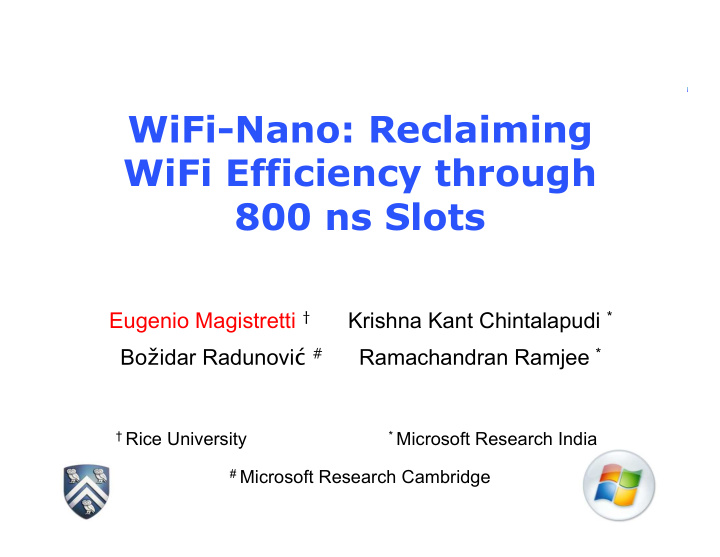



WiFi-Nano: Reclaiming WiFi Efficiency through 800 ns Slots Eugenio Magistretti † Krishna Kant Chintalapudi * Bo ž idar Radunovi ć # Ramachandran Ramjee * † Rice University * Microsoft Research India # Microsoft Research Cambridge
Problem Overview [Mbps] ~55 Mbps 1999 1997 2003 2009 2012 802.11 802.11a/b 802.11g 802.11n 802.11ac/ad § 802.11 data-rates have increased from 1 Mbps to 1 Gbps § Throughput performance has not seen a commensurate increase
Contribution WiFi-Nano increases 802.11 throughput up to 100%
Why Throughput << Data-rate? Medium ACK Preamble Data Access 101.5µs 20µs 224µs 44µs 54 Mbps SIFS DIFS 7 6 5 4 3 2 1 0 405.5 µs Medium ACK Access Preamble Data 36µs 32µs 40µs 101.5µs 300 Mbps DIFS SIFS 7 6 5 4 3 2 1 0 µs 225.5 Medium ACK Access Preamble Data 44µs 101.5µs 40µs 20µs 600 Mbps DIFS SIFS 7 6 5 4 3 2 1 0 µs 221.5
Why Throughput << Data-rate? Medium ACK Preamble Data Access Overhead ~45% 101.5µs 20µs 224µs 60µs 54 Mbps SIFS DIFS 7 6 5 4 3 2 1 0 405.5 µs Medium ACK Access Preamble Data Overhead ~82% 101.5µs 52µs 32µs 40µs 300 Mbps SIFS 7 6 5 4 3 2 1 0 µs 225.5 Medium ACK Overhead ~91% Access Preamble Data 101.5µs 60µs 40µs 20µs 600 Mbps SIFS 7 6 5 4 3 2 1 0 µs 221.5 802.11 overhead does not scale with data-rate
Motivation Overhead Components SIFS 16% Preambles 40% Communications Overhead Cannot be removed! Slot Duration 42% ACK 2% Single Link Case Medium Access Preamble Data Preamble+ACK 101.5µs 40µs 20µs 44µs DIFS SIFS 7 6 5 4 3 2 1 0
Motivation Overhead Components SIFS 14% Preambles 34% Slot Duration 23% ACK 2% Collisions 27% Collisions 27% Multiple Links Case (30)
Objective SIFS 14% Preambles 34% Slot Duration 23% ACK 2% Collisions 27% Collisions 27% § Reduce slot duration q and reduce the occurrence of collisions q … while preserving fairness § Remove SIFS
Challenge: Slot Duration § 802.11a/n slot duration of 9 µ s is close to the minimum feasible 802.11 Slot A 0 û B Clear ¡Channel PropagaDon Assessment ¡(CCA) 1 4 ¡µs A 3 ü B Rx/Tx ¡Hardware 0 PropagaDon Clear ¡Channel Turnaround 1 Assessment ¡(CCA) 4 ¡µs 4 ¡µs Key assumption: Preamble detection and transmission are serial
Speculative Preambles Preamble detection and transmission occur in parallel Clear Channel Assessment may take multiple slots The slot time can be reduced to a round-trip propagation delay Slot Time (800 ns)
Speculative Preambles Slot Time (800 ns) As soon as the backoff 1. Preamble Node ¡A expires, a node transmits its 1 0 preamble CCA: A node transmitting a 2. preamble continues to û Node ¡B attempt to detect incoming Preamble 3 2 1 0 preambles A node aborts its 3. transmission if it detects a Node ¡C û preceding preamble Preamble 2 1 0 Medium Access time decreases from 101.5 µ s to 7.6 µ s
WiFi-Nano Design Objectives Techniques ü § Speculative Preambles § Slot Time Duration § Probabilistic Collision § Collisions Resolution § Fairness § Counter Roll-back § Minimum Slot Size § SIFS § Speculative ACKs
Implementation § Detect preambles and their starting time under interference [PN1] [PN1,PN2] [PN1, PN2,PN3] + + Δ Δ PN1 [PN2] [PN2,PN3] Lattice + Δ PN2 Δ Correlator [PN3] Δ PN3 § Simultaneously transmit and detect preambles Tx Rx Analog Self-Interference QH Noise Canceller Canceller Analog Radio Front-end § Interference may require longer preambles
Results § Experiments q Reliability of Preamble Detection q Efficiency Gain and Analysis q Fairness Lyrtech Qualnet
Preamble Detection Can nodes reliably detect preambles reliably detect preambles despite self-interference? despite self-interference? Can nodes Slightly longer preambles permit to maintain reliability
Efficiency Efficiency f(data rate, #nodes) WiFi-Nano increases the throughput up to 100%
Efficiency Efficiency f(data rate, slot time) WiFi-Nano .11a/n .11b WiFi-Nano increases the throughput up to 100%
How to Achieve More? Frame Aggregation § Works only for single-link bulk downloads § Practically difficult to achieve q Small packets (TPC ACKs) q Short flows (HTTP) q Delay sensitive applications (TPC, VoIP)
Frame Aggregation § Practically difficult to achieve Related work reports 18 kB as average aggregation § At 18 kB, WiFi-Nano gains 25% over 802.11 at 600 Mbps
Summary 802.11 overhead can be > 90% § WiFi-Nano permits to q Reduce the slot time to 800 ns q Reduce the occurrence of collisions to nearly 0 q Remove SIFS WiFi-Nano increases 802.11 throughput up to 100%
WiFi-Nano: Reclaiming WiFi Efficiency through 800 ns Slots Q&A Eugenio Magistretti † Krishna Kant Chintalapudi * Bo ž idar Radunovi ć # Ramachandran Ramjee * † Rice University * Microsoft Research India # Microsoft Research Cambridge
Recommend
More recommend